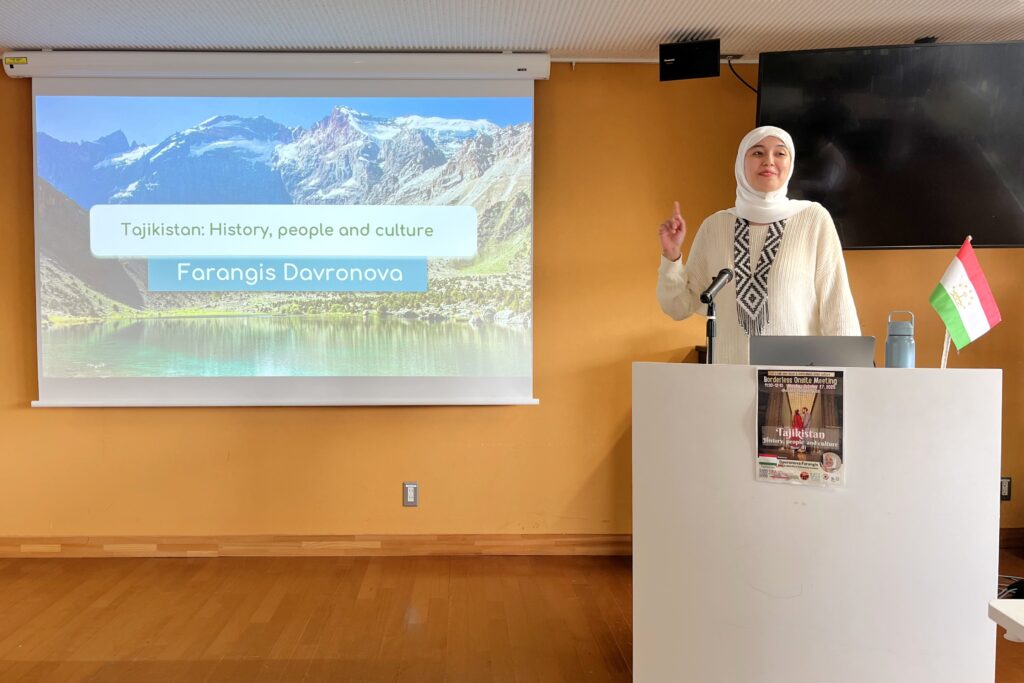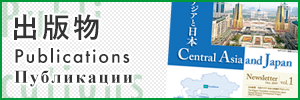 On October 27, 2025, NipCA Fellow and PhD Candidate in International Public Policy, Davronova Farangis, delivered an engaging presentation titled “Tajikistan: History, People, and Culture” as part of the NipCA Fellows’ cultural seminar series. Through rich visuals and storytelling, Ms. Davronova guided the audience into the heart of Tajikistan— a country whose landscapes, languages, and traditions intertwine Persian heritage, Islamic civilization, and Soviet past.
On October 27, 2025, NipCA Fellow and PhD Candidate in International Public Policy, Davronova Farangis, delivered an engaging presentation titled “Tajikistan: History, People, and Culture” as part of the NipCA Fellows’ cultural seminar series. Through rich visuals and storytelling, Ms. Davronova guided the audience into the heart of Tajikistan— a country whose landscapes, languages, and traditions intertwine Persian heritage, Islamic civilization, and Soviet past.
To open her presentation, Ms. Davronova invited the audience to visualize Tajikistan as both ancient and modern — a crossroads of civilizations located between Afghanistan, China, Kyrgyzstan, and Uzbekistan. The presentation then journeyed through the layered history of Tajikistan, tracing its evolution across centuries. Ms. Davronova began with the Achaemenid and Sassanian periods, when the lands of present-day Tajikistan formed part of the Persian world, leaving linguistic and artistic legacies still visible today. The Islamic era that followed in the 7th and 8th centuries brought new forms of learning, law, and literature. The rise of the Samanid Empire, with its capital in Bukhara and Samarkand, was presented as a golden age for the Tajik language and identity, giving rise to figures like Ismoil Somoni, whose name now adorns the national currency. Under Russian imperial expansion in the 19th century and later within the Soviet Union, Tajikistan underwent profound transformation. Education, urban planning, and secular governance reshaped society, while Soviet modernity coexisted uneasily with traditional customs and faith. Following independence in 1991, Tajikistan endured a devastating civil war (1992–1997), after which the nation embarked on a long process of peacebuilding and identity reconstruction, an effort that continues to define the post-Soviet era.
Moving beyond history, the presentation explored Tajik culture through its crafts, music, and traditions of hospitality. Ms. Davronova highlighted Suzani embroidery, carpet weaving, and wood carving as art forms that express patience, creativity, and craftsmanship. The classical musical genre Shashmaqom, recognized by UNESCO, blends rhythm, poetry, and mysticism, embodying the soul of Tajik artistic heritage. She described how family and community remain at the center of social life. Guests are welcomed with tea, fruit, and sweets — gestures symbolizing warmth and respect.
Ms. Davronova also took the audience on a visual journey through some of Tajikistan’s most remarkable places — from the National Museum of Tajikistan and the elegant Navruz Palace to the Dushanbe Central Mosque and the Ismaili Centre. Each of these landmarks, Ms. Davronova explained, brings together Persian, Islamic, and modern elements, reflecting how Tajik culture has always absorbed new influences while staying rooted in its traditions.
Beyond the cities, Tajikistan’s landscapes carry their own stories. In the east rise the Pamir Mountains, often called the “Roof of the World,” home to the high-altitude town of Murghab, where life continues against the backdrop of snow peaks and open sky. Further north, in the Yagnob Valley, descendants of the ancient Sogdians still speak the Yagnobi language, keeping alive one of the oldest cultural threads in Central Asia. The Fann Mountains, with their clear blue lakes such as Iskanderkul and Haft Kul, embody both the beauty of nature and the quiet spirituality that shapes Tajik life.
In her closing remarks, Ms. Davronova described Tajik culture as a living conversation between past and present, tradition and change. From the poetry of Rudaki and Rumi to the bright colors of Suzani embroidery and the haunting melodies of Shashmaqom, Tajik heritage, she said, tells a story of resilience — of people who have rebuilt their identity time and again through art, language, and faith.
Her presentation offered the participants not only an introduction to Tajikistan but also an invitation to see culture as both memory and bridge — connecting Central Asia’s mountains to the wider world.




